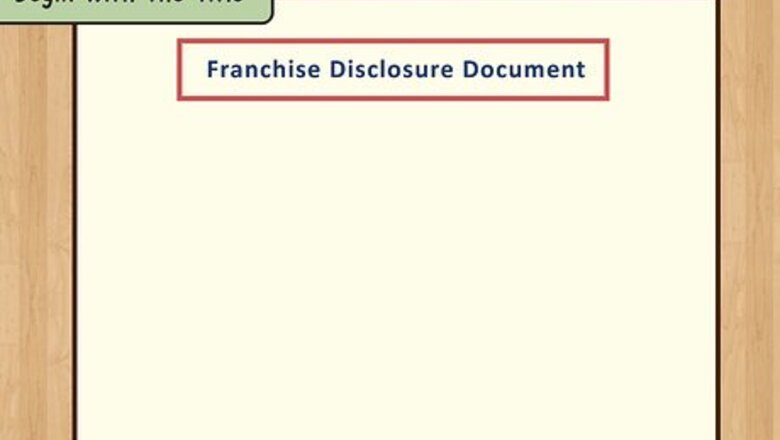
views
Drafting the Cover Page
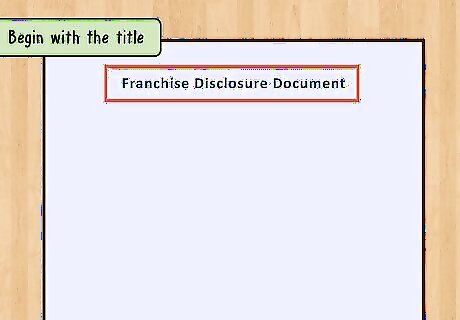
Begin with the title. The first section of the FDD is referred to as the "Cover Page," although in fact it may actually be longer than a single page. The FTC Franchise Rule is very specific in prescribing some of the details of the FDD. The title of the document, by law, is to be “Franchise Disclosure Document.” You must present this in bold type, in all capital letters.
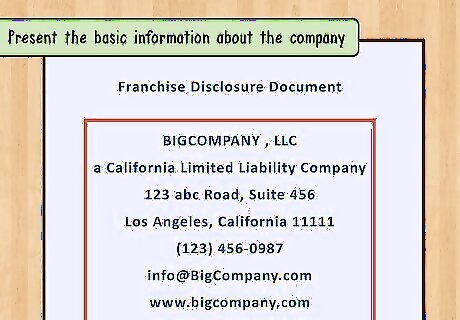
Present the basic information about the company. Following the title, your cover page must include the basic identifying information about the franchise that you are offering for sale. In particular, this section of the cover page must include the following details: the franchise name the parents of the franchisor, as well as predecessors and affiliates the type of business organization (e.g., restaurant, hair salon, electronics retail sales, and so on) principal business address telephone number email address primary Internet home page address
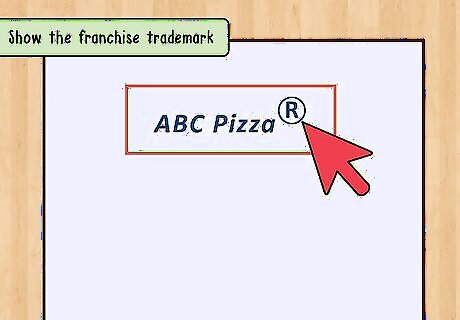
Show the franchise trademark. Most businesses use some sort of registered trademark or logo in their operations, and a franchise is usually going to be expected to use the same trademark. You must place on the cover page a sample of the franchise trademark that any purchaser will be expected to use.
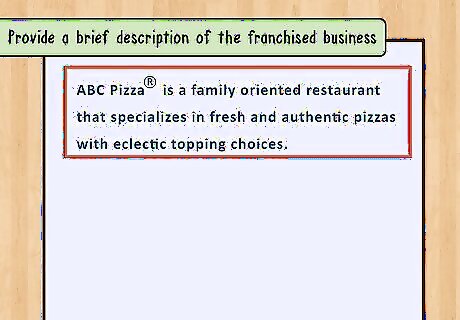
Provide a brief description of the franchised business. This is still a very short description, but you need to provide more information than just the type of business that was already mentioned. For example, if you are offering franchise opportunities for a pizza restaurant, you might describe it here as, “ABC Pizza is a family oriented restaurant that specializes in fresh and authentic pizzas with eclectic topping choices.”
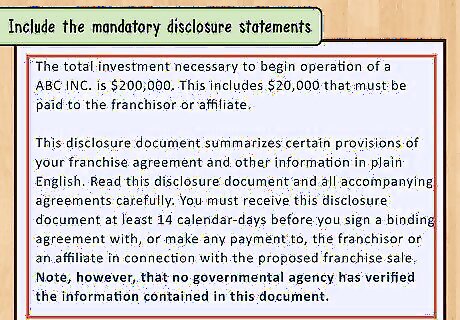
Include the mandatory disclosure statements. The FTC requires that the title page include six specific statements. The instructions are clear that some of the information must be provided in boldface type. These mandatory statements are as follows: ”The total investment necessary to begin operation of a [franchise system name] franchise is [the total amount of Item 7]. This includes [the total amount in Item 5] that must be paid to the franchisor or affiliate.” ”This disclosure document summarizes certain provisions of your franchise agreement and other information in plain English. Read this disclosure document and all accompanying agreements carefully. You must receive this disclosure document at least 14 calendar-days before you sign a binding agreement with, or make any payment to, the franchisor or an affiliate in connection with the proposed franchise sale. [The following sentence in bold type] Note, however, that no governmental agency has verified the information contained in this document.” ”The terms of your contract will govern your franchise relationship. Don’t rely on the disclosure document alone to understand your contract. Read all of your contract carefully. Show your contract and this disclosure document to an advisor, like a lawyer or an accountant.” ”Buying a franchise is a complex investment. The information in this disclosure document can help you make up your mind. More information on franchising, such as “A Consumer’s Guide to Buying a Franchise,” which can help you understand how to use this disclosure document, is available from the Federal Trade Commission. You can contact the FTC at 1-877-FTC-HELP or by writing to the FTC at 600 Pennsylvania Avenue, NW, Washington, D.C. 20580. You can also visit the FTC’s home page at www.ftc.gov for additional information. Call your state agency or visit your public library for other sources of information on franchising.” ”There may also be laws on franchising in your state. Ask your state agencies about them.” [The issuance date - date of the FDD].
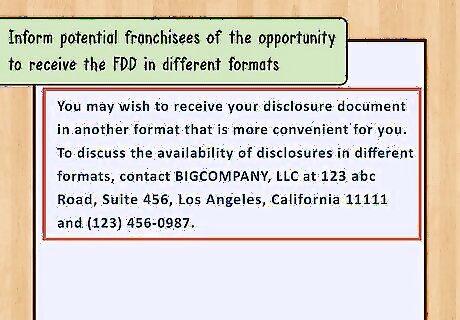
Inform potential franchisees of the opportunity to receive the FDD in different formats. At your option, you may provide the FDD either in print on paper, or online, or by email. If you choose to provide the FDD in alternative formats, you should include a statement to that effect, to let potential buyers know how they may receive it.
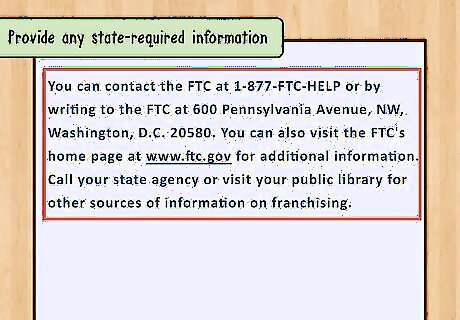
Provide any state-required information. If your state has separate franchise disclosure laws, you may be required to provide additional information on the cover page beyond what is required by the FTC. If so, you may add it at the end of the FTC-required statements. You may use an addendum or additional pages, as necessary.
Drafting the Table of Contents

Title the Table of Contents. It seems basic, but when you are dealing with federal regulations, you need to follow instructions. The Table of Contents must bear the title, “Table of Contents.”
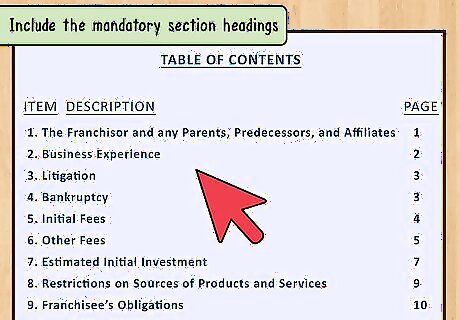
Include the mandatory section headings. Following the cover page information, you are expected to provide a full table of contents. Because the contents of the FDD are expected to be standardized, the Table of Contents will be standard as well. Your Table of Contents must include the following 23 items, with the page number of the FDD where each section begins: 1. The Franchisor and any Parents, Predecessors, and Affiliates 2. Business Experience 3. Litigation 4. Bankruptcy 5. Initial Fees 6. Other Fees 7. Estimated Initial Investment 8. Restrictions on Sources of Products and Services 9. Franchisee’s Obligations 10. Financing 11. Franchisor’s Assistance, Advertising, Computer Systems, and Training 12. Territory 13. Trademarks 14. Patents, Copyrights, and Proprietary Information 15. Obligation to Participate in the Actual Operation of the Franchise Business 16. Restrictions on What the Franchisee May Sell 17. Renewal, Termination, Transfer, and Dispute Resolution 18. Public Figures 19. Financial Performance Representations 20. Outlets and Franchisee Information 21. Financial Statements 22. Contracts 23. Receipts
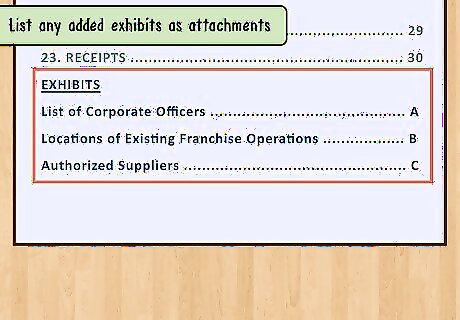
List any added exhibits as attachments. At the end of the Table of Contents, include a section of “Exhibits.” Give the page number on which the “Exhibits” section begins. Under the heading, list each exhibit separately with lettered section numbers. For example, the end of your Table of Contents may look like this: 22. Contracts 23. Receipts Exhibits A. List of Corporate Officers B. Locations of Existing Franchise Operations C. Authorized Suppliers
Drafting the Body of the FDD
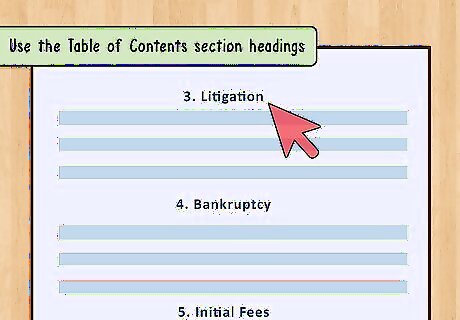
Use the Table of Contents section headings. For the main body of your FDD, you will need to follow the section headings that are listed in the Table of Contents. These sections are required so that you will provide any potential buyer with all the information that he or she would need to make an informed decision about buying your franchise.
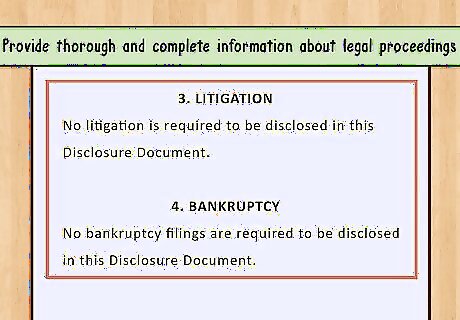
Provide thorough and complete information about legal proceedings. The purpose of the FDD is to disclose complete information about the franchise to prospective buyers. You are not to use this as a marketing tool and present only the positive information. For example, Sections 3 and 4 expect you to be honest in reporting any litigation that the company has been involved in (Section 3) and any bankruptcy involvement of the parent company or any of its officers (Section 4). You must provide complete information for any such cases, including the venue, case numbers, other parties involved, and descriptions of final decisions.
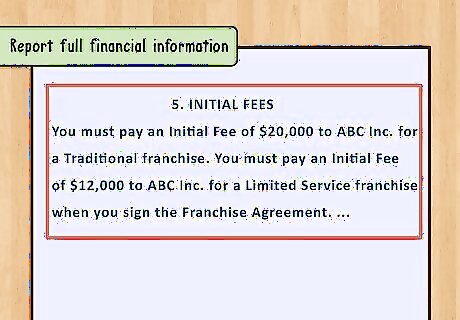
Report financial information. Sections 5, 6, 7, 10, and 21-23 are all about the company’s financial information. You will need to gather financial information about the company as a whole and disclose the company’s financial statements. You will also need to report the expectations of the franchisee, regarding the financial investment that will be expected in order to start up the franchise. Note that franchisors do not have to provide franchisees with information on sales, earnings, or expenses.
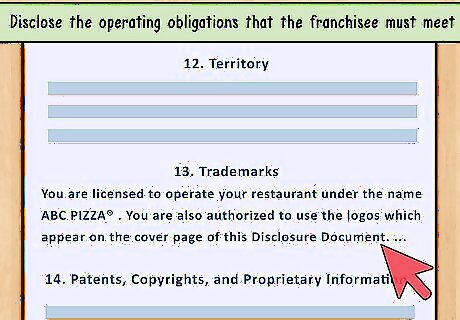
Disclose the operating obligations that the franchisee must meet. Several sections of the FDD require you to report the obligations that the franchisee will have to adhere to in running the franchise. These will be such things as territory (Sec. 12), the company’s trademarks (Sec. 13), patents and proprietary information (Sec. 14), and product requirements (Sec. 16). Note if there are obligations guaranteed by a subsidiary or another entity to or for the franchisee.
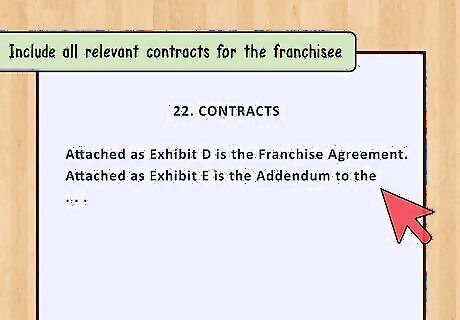
Include all relevant contracts for the franchisee. The FDD is expected to contain copies of all legal agreements that you will require of the franchisee. This is to include the franchise offering, the franchise agreement, and any lease, options, and purchase agreements. You may also need to include financing agreements, product supply agreements, software licensing agreements, personal guarantees, and any other contracts that are specific to these circumstances.
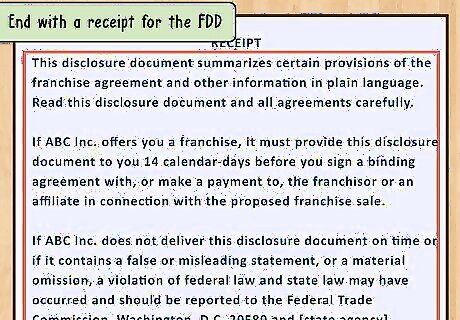
End with a receipt for the FDD. The final section of the FDD is to be a detachable acknowledgment of receipt of the disclosure document. You should include two copies of this. This section is designed so the prospective franchisee can remove the signature page, sign to indicate receipt of the FDD, and then give a copy to you for your records. The receipt is supposed to include the following language: "RECEIPT: This disclosure document summarizes certain provisions of the franchise agreement and other information in plain language. Read this disclosure document and all agreements carefully. If [name of franchisor] offers you a franchise, it must provide this disclosure document to you 14 calendar-days before you sign a binding agreement with, or make a payment to, the franchisor or an affiliate in connection with the proposed franchise sale.[or sooner if required by applicable state law] If [name of franchisor] does not deliver this disclosure document on time or if it contains a false or misleading statement, or a material omission, a violation of federal law and state law may have occurred and should be reported to the Federal Trade Commission, Washington, D.C. 20580 and [state agency]." Following the receipt statement, you should disclose the name, principal business address and telephone number of each franchise seller offering the franchise. State the issuance date. Include the following statement: “I received a disclosure statement dated ____ that included the following exhibits:” [list any exhibits] Provide a space for the franchisee’s signature and date.
Understanding the Franchise Rule
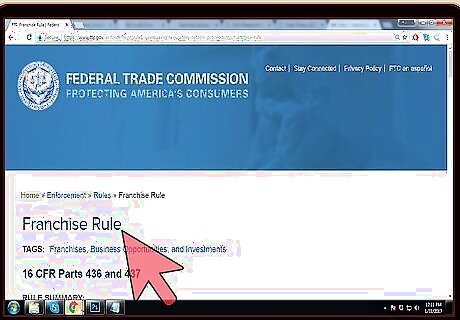
Study the FTC Requirements. If you are going to be in the business of operating and selling franchise opportunities, you must make yourself familiar with the requirements of the Federal Trade Commission (FTC). The FTC oversees and regulates franchise sales in the United States. You can visit the FTC website at www.ftc.gov, and search for information about franchises.
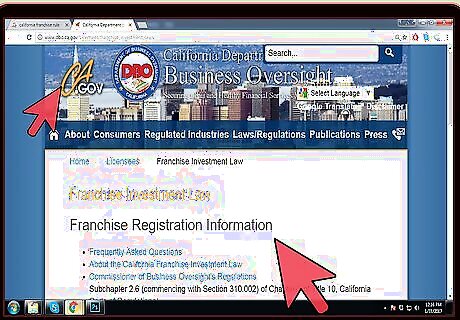
Discover your state’s own franchise rules. For most of the United States, the FTC’s Franchise Rule will be the governing requirement. However, several states have also passed their own franchise statutes, beginning with California in 1971. You should check with your state’s Secretary of State or Attorney General’s offices to find out if there are specific state laws that govern franchise offerings in your state. As of the writing of this article, the following states have securities offices and specific statutes regarding oversight of franchises within the state: California, Connecticut, Hawaii, Indiana, Maryland, Minnesota, Nebraska, New York, North Dakota, Oregon, Rhode Island, South Dakota, Virginia, Washington, and Wisconsin.
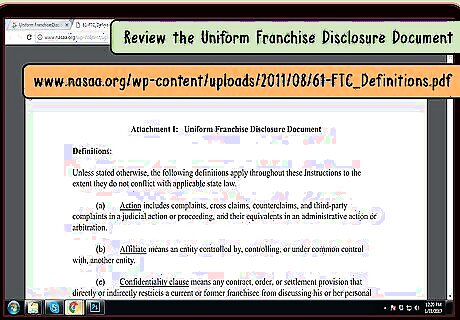
Review the Uniform Franchise Disclosure Document. The Uniform Franchise Disclosure Document is a sample that is designed to provide the basis for a valid Franchise Disclosure Document in most states. If you follow the example and explanations of the Uniform FDD, then your own FDD should comply with federal expectations.

Consult with a franchise attorney and/or accountant to prepare your FDD. The FDD is intended to be a very comprehensive document. They tend to run from 100-200 pages long, and include very thorough financial and legal information about your company. This is not something to take lightly. You should work together with your company’s attorney and accountant to finalize the FDD.



















Comments
0 comment